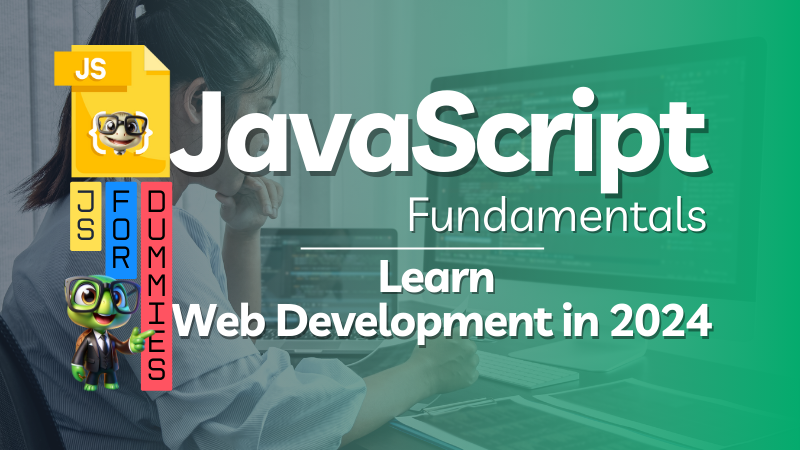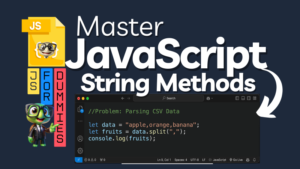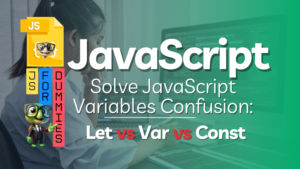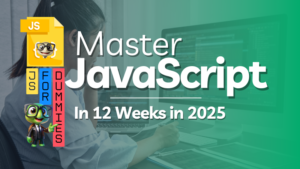
Discover the ultimate roadmap to mastering JavaScript for web development in 2025. This beginner-friendly guide covers essential syntax, practical examples, and real-world tips to help you quickly become confident in JavaScript.
Introduction: Why Learn JavaScript in 2025?
If you want to become a web developer in 2025, JavaScript is not optional—it’s essential. Every interactive button you click, every animation you see on a website, and most modern web applications you use daily are powered by JavaScript.
Unlike many programming languages that stay mostly in the background, JavaScript lives at the heart of the internet. It’s what makes websites do things instead of just displaying static text and images.
Here’s why learning JavaScript in 2025 is so powerful:
- Backbone of the Web: HTML builds structure, CSS adds style, but JavaScript adds interactivity.
- Universal Usage: Works in web browsers, on servers with Node.js, and even in mobile or desktop apps.
- High Demand: Employers seek developers skilled in JavaScript frameworks like React, Vue, and Angular.
- Future-Proof Skill: Whether you’re freelancing, building startups, or joining big tech companies, JavaScript will still be in demand.
This tutorial gives you a short but detailed roadmap to learning JavaScript the right way. We’ll cover syntax, variables, functions, objects, arrays, event handling, asynchronous programming, and more—with clear examples you can try instantly.
Table of Contents
- 1. Getting Started with JavaScript
- 2. Setting Up Your Development Environment
- 3. Learning Basic Syntax and Concepts
- 4. Understanding JavaScript Variables and Data Types
- 5. Mastering Functions in JavaScript
- 6. Diving into Control Flow Statements
- 7. Exploring Objects and Arrays
- 8. Event Handling for Dynamic Web Pages
- 9. Learning Asynchronous JavaScript: Promises and Async/Await
- 10. Building Real-World Projects
- FAQs
- Conclusion
1. Getting Started with JavaScript
JavaScript is a scripting language that runs directly in your browser. That means you don’t need to install heavy compilers or complex IDEs just to get started. All you need is:
- A browser like Chrome or Firefox.
- A simple text editor like Visual Studio Code.
Why do developers love JavaScript?
- It’s versatile. You can create everything from calculators to real-time chat apps.
- It’s easy to learn compared to languages like Java or C++.
- It has a huge ecosystem. Thousands of libraries and frameworks help you build apps faster.
Think of JavaScript as the glue that brings your websites to life.
2. Setting Up Your Development Environment
To begin coding, follow these steps:
- Install a Code Editor:
- VS Code: Lightweight, feature-rich, and widely used.
- Example:
- Open Visual Studio Code and install it.
- Install Node.js:
- Node.js allows you to run JavaScript outside the browser.
- Example Command:
node -v npm -v
- Choose a Browser Developer Tool:
- Chrome DevTools or Firefox Developer Tools are excellent options for debugging.
Before you start coding, set up your environment properly.
Install a Code Editor
The best choice is Visual Studio Code (VS Code). It’s free, lightweight, and packed with developer-friendly features.
- Download from code.visualstudio.com.
- Install extensions like ESLint (for cleaner code) and Prettier (for auto-formatting).
Install Node.js
Node.js lets you run JavaScript outside the browser. This is useful for backend coding, running servers, or using package managers like npm.
- Download Node.js from nodejs.org.
- After installing, check version:
node -v
npm -v
Browser Developer Tools
Your browser comes with powerful built-in developer tools.
- Press F12 in Chrome or Firefox.
- Use the Console tab to run JavaScript directly.
- Use the Elements tab to see how JavaScript interacts with HTML.
3. Learning Basic Syntax and Concepts
JavaScript Basics
JavaScript syntax is what tells the browser what to do.
Hello World Example
console.log("Hello, World!");
This one line prints a message to the browser’s console. It’s the traditional first program in almost every language.
Comments
Comments explain code but are ignored by the computer.
// Single-line comment
/* Multi-line
comment */
Semicolons
JavaScript doesn’t require semicolons, but adding them prevents errors and makes your code cleaner.
4. Understanding JavaScript Variables and Data Types
Variables are like boxes that hold values.
Declaring Variables
You can use var, let, or const.
- var – Old way, not recommended anymore.
- let – Modern and flexible.
- const – Use for values that don’t change.
Examples:
var name = "Alice";
let age = 25;
const PI = 3.14159;
Data Types in JavaScript
- String – Text values.
let greeting = "Hello World"; - Number – Includes integers and decimals.
let score = 95.5; - Boolean – True or false.
let isLoggedIn = true; - Null – Empty or nothing.
- Undefined – Variable declared but not assigned a value.
Pro tip: JavaScript is dynamically typed, meaning you don’t have to specify data types explicitly.
5. Mastering Functions in JavaScript
Functions are reusable blocks of code.
Function Declaration
function greet() {
console.log("Hello!");
}
greet();
Function with Parameters
function add(a, b) {
return a + b;
}
console.log(add(5, 10));
Arrow Functions
Introduced in ES6, they are shorter and cleaner.
const multiply = (x, y) => x * y;
console.log(multiply(3, 4));
Functions help break down large problems into smaller, manageable steps.
Syntax
function functionName(parameters) {
// Code to execute
}
Example 1: Simple Function
function sayHello() {
console.log("Hello!");
}
sayHello();
Example 2: Function with Parameters
function add(a, b) {
return a + b;
}
console.log(add(5, 10));
Example 3: Arrow Functions
const multiply = (x, y) => x * y;
console.log(multiply(3, 4));
6. Diving into Control Flow Statements
Control flow manages the execution of code.
If-Else Statements
if (condition) {
// Code to execute if true
} else {
// Code to execute if false
}
Example 1:
let score = 85;
if (score > 90) {
console.log("Excellent");
} else {
console.log("Good");
}
If-Else Example
let score = 85;
if (score > 90) {
console.log("Excellent");
} else {
console.log("Good");
}
Other control flows:
- switch-case: Handles multiple conditions.
- loops (for, while, do-while): Repeat tasks until conditions are met.
Example loop:
for (let i = 1; i <= 5; i++) {
console.log("Number: " + i);
}7. Exploring Objects and Arrays
Objects and arrays are the foundation of JavaScript data handling.
Objects
Objects store data in key-value pairs.
Example 1: Create an Object
let person = {
name: "John",
age: 30,
isEmployed: true,
};
console.log(person.name);
Arrays
Arrays store multiple values.
Example 1:
let fruits = ["Apple", "Banana", "Cherry"];
console.log(fruits[1]); // Banana
You can loop through arrays with for or modern methods like .forEach() or .map().
8. Event Handling for Dynamic Web Pages
Events add interactivity to websites. JavaScript responds to user actions with events.
Example: Button Click
<button onclick="showAlert()">Click Me</button>
<script>
function showAlert() {
alert("Button clicked!");
}
</script>
Events make websites interactive: detecting clicks, typing, scrolling, or even mouse movements.
9. Learning Asynchronous JavaScript: Promises and Async/Await
Asynchronous programming handles long-running tasks. Some tasks, like fetching data from an API, take time. JavaScript handles these with asynchronous programming.
Promises
let promise = new Promise((resolve, reject) => {
resolve("Success!");
});
promise.then((message) => console.log(message));
Async/Await
async function fetchData() {
let data = await fetch("https://api.example.com");
console.log(data);
}
fetchData();
10. Building Real-World Projects
The best way to learn is by building projects. Start small, then grow:
- To-Do List App: Add, remove, and mark tasks as complete.
- Weather App: Fetch real-time data from an API.
- Quiz Game: Test knowledge with interactive questions.
Projects give you confidence and help you understand how everything connects
FAQs
Q1: How long does it take to learn JavaScript?
With consistent daily practice, you can learn the basics in 1–2 months. Mastery takes longer, depending on your projects.
Q2: Is JavaScript beginner-friendly?
Yes! It’s one of the best first languages because you see results instantly in your browser.
Q3: Should I learn JavaScript in 2025?
Absolutely. JavaScript continues to grow, and frameworks built on it dominate the web development industry.
Conclusion
Learning JavaScript in 2025 is your golden ticket into the world of web development. It’s versatile, powerful, and in high demand.
Start with the basics, practice writing small scripts, then move on to bigger projects. By following this guide and consistently coding, you’ll build the skills to create interactive websites, apps, and beyond.
Remember: the more you practice, the faster you’ll learn. JavaScript is not just a programming language—it’s your passport to building the digital future.





